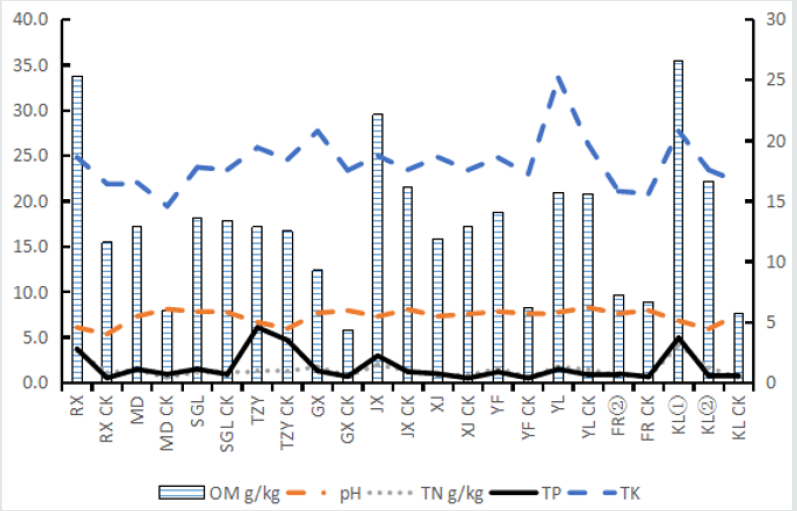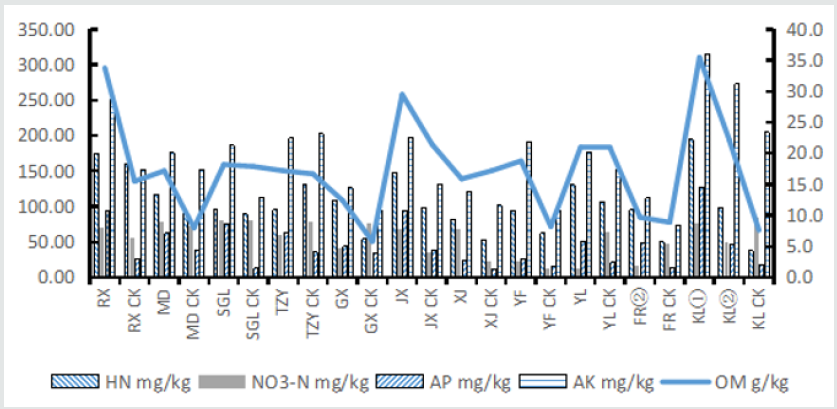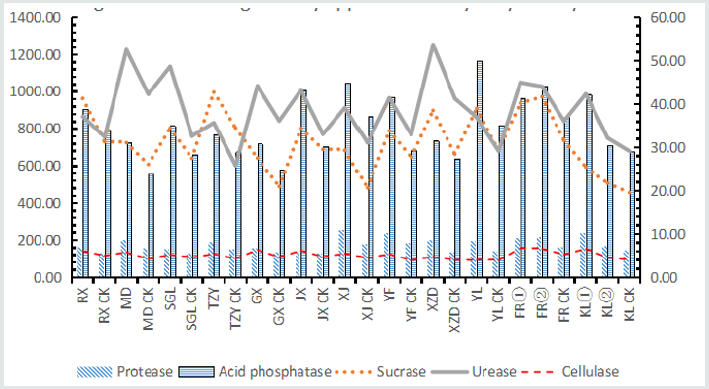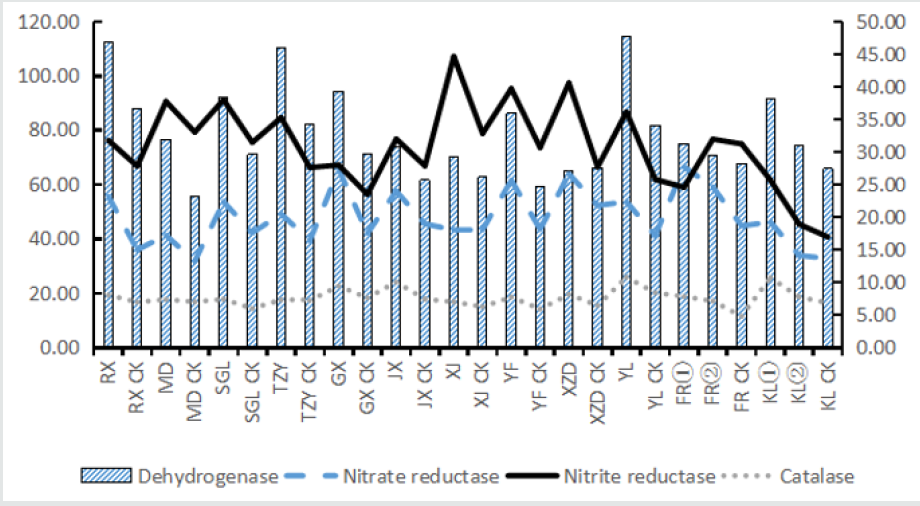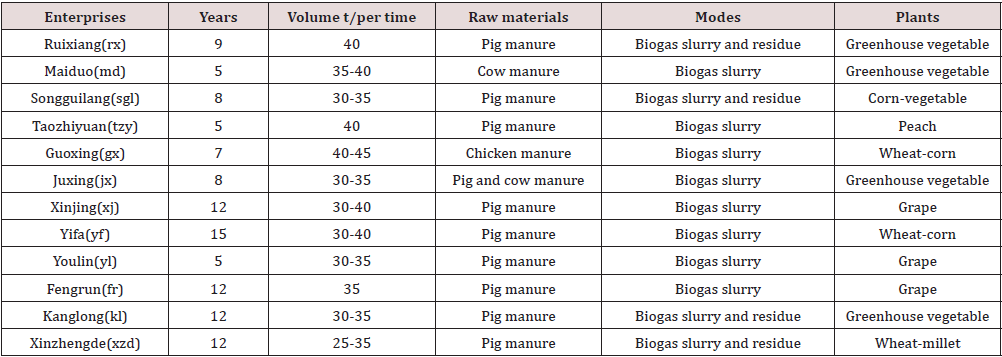
Lupine Publishers Group
Lupine Publishers
Menu
ISSN: 2637-4676
Research Article(ISSN: 2637-4676) 
Effects of Biogas Slurry Utilization in Long-Term on Soil Nutrients and Enzyme Activities Volume 8 - Issue 3
Wu Jichengab1,2*, Pan Xiaoyingab1,2, Yang Yonghuiab1,2, Gao Cuiminab1,2, Wang Yueab1,2 and Li Minjieac1,3
- 1Institute of Plant Nutrition & Resource Environment, Henan Academy of Agricultural Sciences, China
- 2Yuanyang Experimental Station of Crop Water Use, Ministry of Agriculture, China
- 3Agricultural College of Zhengzhou University, China
Received: February 18, 2020; Published: February 27, 2020
Corresponding author: Wu Jichenga, Institute of Plant Nutrition & Resource Environment, Henan Academy of Agricultural Sciences, China
DOI: 10.32474/CIACR.2020.08.000286
Abstract
In order to find out the effect of biogas slurry utilization in long-term on soil nutrient and soil enzyme activity, the typical breeding enterprises of biogas slurry utilization in Henan Province was investigated by April and October 2019. The results showed that the content of organic matter, nitrogen, phosphorus and potassium in biogas slurry was relatively low, including 0.26g/l of organic matter, 1.27g/l of total nitrogen, 0.19g/l of total phosphorus and 0.94g/l of total potassium. After years later by biogas slurry irrigation and application, the nutrient factors of the soil surface layer were improved, among which the organic matter in the soil surface layer increased by 0.2-27.9g/kg, the total nitrogen increased by 0.02-2.7g/kg, and the total phosphorus increased by 0.1-3.25g/kg the mode of combining the biogas residue with the biogas liquid of KANGLONG biogas was the largest one. Total potassium increased by 0.2-5.53g/kg, with an increase of 1.14-28.10% which of YOULIN was the largest one. The value of pH changed to conducive to soil nutrient release. The accumulation of available P in soil is increased by 9.18-108.7mg/kg, which is consistent with the trend of organic matter and total P content. The hydrolyzed N is increased by 0.2-156.79mg/kg, which is consistent with the trend of organic matter and total N content, and the available K is increased by 19.23-109.45mg/kg, which is consistent with the trend of total K. That all are the results of long-term accumulation by use of biogas slurry. The activities of soil hydrolase and oxidoreductase significantly were increased by use of biogas slurry. Compared with the control farmland, protease increased by 0.49-4.02IU/L, increased by 8.77-64.42%, invertase increased by 51.34-235.25IU/L, increased by 11.24-41.83%, urease increased by 71.78-374.54IU/L, increased by 10.55-49.12%, acid phosphatase increased by 1.49-14.77IU/L, increased by 5.16-45.86%, cellulase increased by 2.51-58.81IU/L, It increased by 2.72-61.40%, nitrate reductase by 0.48-9.82IU/L, 3.51-55.95%, nitrite reductase by 0.7312.89IU/L, 2.34-51.47%, dehydrogenase by 0.11-3.88IU/L, 3.51-62.19%, catalase by 2.93-32.77IU/L, 4.33- 46.18%. There was a significant correlation between soil nutrients and enzyme activity, among which soil organic matter, N, P, K, dehydrogenase and catalase activities were all positively correlated, soil total N, hydrolyzed N, available P and cellulase were also positively correlated, organic matter, available K and cellulase were significantly correlated. At the same time, there are significant or extremely significant correlation between different soil enzymes.
Keywords:Biogas slurry; Biogas slurry utilization; Soil nutrients; Soil enzyme activity; Long-Term; Eutrophication
Introduction
Biogas slurry is the liquid residue of anaerobic fermentation of livestock manure, crop straw and other organic matters. It only contains available N, P, K, and is also rich in trace elements such as S, Ca, Mg, humic acid, amino acid, organic matter, et a [1,2]. Biogas slurry can not only improve the soil, improve the soil nutrient status [3,4], promote the growth and development of crops [5,6], and improve crop photosynthetic characteristics [7,8], and improve crop yield and quality [9-11]. And which can also affect nitrogen absorption and water consumption, and improve protein content, dry matter accumulation and nitrogen use efficiency of winter wheat [12-15] and reduce soil C / N mineralization and greenhouse gas emission [16]. More importantly, by use of biogas slurry, it can also improve the biological characteristics of soil [17], and improve the activity of soil enzymes [18-20], and then affect the activity indexes of soil quality and the evaluation indexes of soil fertility, and play an important role in the soil ecosystem [21]. Therefore, biogas slurry is considered to be a good organic fertilizer and the best alternative product for increasing crop yield and nutrients [22]. However, a large number of long-term irrigation and application of biogas slurry, because of its rich and effective nutrients, is very easy to cause soil nitrogen and phosphorus accumulation, and form environmental problems such as point and surface soil pollution and water eutrophication. Furthermore, scientific and reasonable biogas slurry irrigation can slow down the over eutrophication of farmland fertility [23], and improve soil microbial biomass and activity [24,25], so as to realize the sustainable utilization of soil. The output of biogas slurry is more than 300 million tons per year in Henan Province. There have different ways of using biogas slurry, crops and consumption in different enterprises. In order to make better use of biogas slurry, avoid secondary pollution caused by biogas slurry irrigation, and reveal the impact of biogas slurry utilization on soil nutrients and enzyme activity, we have sampled and analyzed the soil of biogas slurry utilization with different service life, consumption and planting methods. It is expected to provide scientific basis for the scientific utilization of biogas slurry and soil fertility.
Samples Collection and Analysis
According to the development scale of the aquaculture industry and the utilization of biogas residue and biogas slurry, the soil samples of 0-100cm of 11 representative aquaculture industries in Henan Province were respectively collected from the biogas slurry utilization plot and the control farmland plot in April and October 2019, which were naturally dried, and then crushed to test and analyze their organic matter, pH, total and effective nitrogen, phosphorus, potassium, nitrate nitrogen, soil enzyme activity, et al, which soil organic matter is determined by potassium dichromate volumetric method, the total nitrogen by semi-micro kelvin method, the total phosphorus and available phosphorus by molybdenum antimony colorimetric method, the total potassium and available potassium atomic absorption spectrometry, the hydrolyzed nitrogen by alkaline solution distillation potentiometric titration method, the nitrate nitrogen by ultraviolet spectrophotometric method, and the soil enzyme activity byadopt corresponding enzyme activity kit for analysis (Table 1).
Results and analysis
Nutrient characteristics of biogas slurry of different aquaculture enterprises in Henan Province
Figure 1: The content of OM, TN, TP and TK in different biogas slury (g/L) of different enterprises.
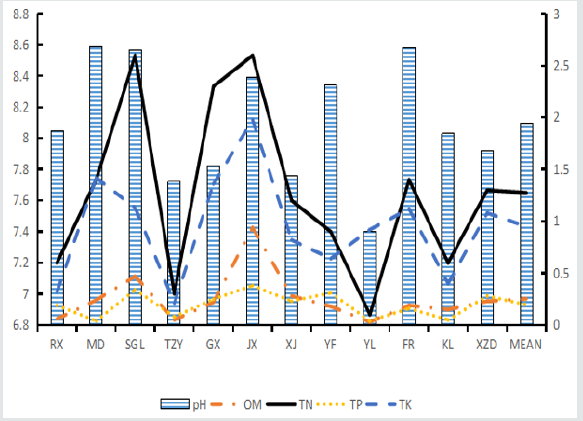
There are obvious differences in organic matter, total nitrogen, total phosphorus, total potassium and pH value in biogas slurry of different aquaculture enterprises (Figure 1). The average content of organic matter is 0.26g/L, and the highest is 0.94g/L, the lowest is only 0.03g/L. The average content of total nitrogen is 1.27g/L, and the highest is 2.6g/L, the lowest is 0.3g/L. The average content of total phosphorus is 0.19g/L, and the highest is 0.38g/L, the lowest is 0.04g/L. The average content of total potassium is 0.94g/L, and the highest is 1.98g/L, the lowest is 0.40g/L. In a word, the nutrient components of biogas slurry irrigated by different enterprises are quite different. The sources of organic matter, total nitrogen, total phosphorus and total potassium are all low, including KL, YL, RX and TZY. The sources of organic matter, total nitrogen, total phosphorus and total potassium are all high, including JX and SGLG. The sources of total phosphorus is low, but the organic matter and total nitrogen, phosphorus and potassium are high, including MD. That of the others enterprises are all in the middle level.
Effects of biogas slurry utilization on soil organic matter, pH and NPK
Soil pH, organic matter, total nitrogen, total potassium,
total phosphorus, available nitrogen, nitrate nitrogen, available
phosphorus and available potassium are effectively improved
by biogas slurry utilization (Figure 2), but there are significant
differences between different nutrient factors. The soil surface
organic matter increased by 0.2g/kg to 27.9g/kg, with an increase
of 0.96% to 367.11%. The mode of combining the biogas residue
and liquid of KL was the most significant. However, the soil organic
matter of XJ decreased by 1.3g/kg, a decrease of 7.56%, which
the main reason was that the vineyard was formed by wasteland
development, but the forest land(CK) was not affected by human
farming activities, and the litter layer was obvious. The pH value
of soil increased and decreased respectively, that of MD, JX, KL, YL,
FR, GX and XJ decreased by 0.79, 0.78, 0.72 0.53, 0.33, 0.29 and 0.24
respectively, with a decrease range of 9.69%, 9.61%, 9.49%, 6.37%,
4.13%, 3.63% and 3.15%, that of RX, TZY, YF and SGL increased by
0.74, 0.70, 0.24 and 0.07 respectively, the decrease range is 13.73%,
11.65%, 3.14% and 0.90% respectively. The increase or decrease is
in favor of the release of soil nutrients, such as the change from acid
to weak alkaline in RX and from alkaline to weak alkaline in MD.
The content of total nitrogen, total phosphorus and total
potassium in the surface soil increased significantly. The total
nitrogen increased by 0.02g/kg to 2.7g/kg, an increase of 2.15%
to 600%, the total phosphorus increased by 0.1g/kg to 3.25g/kg,
an increase of 12% to 663.27%, and the greatest increase was
the mode of combining the biogas residue and liquid of KL. Total
potassium increased by 0.2g/kg to 5.53g/kg, an increase of 1.14%
to 28.10%, and YL increased the most.
In terms of the biogas slurry utilization time, the organic matter,
total nitrogen and total potassium of the greenhouse vegetables
were KL > RX > MD > JX, except MADUO with low basic nutrients,
the increase was basically increased with the increase of time, the
total phosphorus was increased with the increase of utilization
time, that is KL > RX > JX > MD. The organic matter, total nitrogen
and total phosphorus of the mode of grain economy were YF> GX >
SGL, soil total potassium is GX > YF > SGL, which is related to its low
basic nutrients. The mode of orchard planting is the most complex,
soil organic matter is FR> TZY> YL>XJ, soil total nitrogen is FR >
YL > XJ>TZY, soil total phosphorus is XJ> YL> FR>TZY, soil total
potassium is YL > XJ>TZY, which may be related to the amount and
times of irrigation.
The available phosphorus are all increased, while the hydrolyzed
nitrogen and available potassium decreased only in TZY (Figure
3), which was related to the large-scale use of chemical fertilizer
by farmers for planting medicinal materials, while the others all
increased, the nitrate nitrogen increased and decreased differently. The accumulation of available phosphorus increased rapidly due
to the large amount of biogas slurry irrigation, which increased by
9.18mg/kg to 108.7mg/kg, with an increase of 26.76% to 593.99%,
and KL had the largest increase, consistent with the trend of
organic matter and total phosphorus content. Hydrolyzed nitrogen
increased by 0.2mg/kg to 156.79mg/kg, with an increase of 1.14%
to 420.24%, consistent with the trend of organic matter and total
nitrogen content, but RX decreased by 27.22%. Available potassium
increased by 19.23mg/kg to 109.45mg/kg, with an increase of
15.48% to 103.30%, the growth rate of YF was the largest, which
was the result of long-term application of biogas slurry, while TZY
decreased by 25.13%. The nitrate nitrogen content of XJ, YF, JX, RX
and MD increased by 5.85mg to 43.27mg/kg, with and increase of
8.09% to 187.00% respectively, while YL, FR, GX, KL, TZY and SGL
decreased by 0.8mg to 51.42mg/kg, with an increase of 1.00% to
81.04% respectively.
From the time of biogas slurry utilization, the change of available nitrogen, phosphorus and potassium is greater than that of total phosphorus and organic matter. The hydrolyzed nitrogen of greenhouse vegetable is KL > JX > RX > MD, the available phosphorus is KL > RX > JX > MD, the available potassium of soil is RX > KL > JX> MD, and the change trend of available phosphorus is consistent with that of total phosphorus. The hydrolyzed nitrogen of grain economy planting is GX>YF>SGL, the available phosphorus is SGL>YF>GX, the available potassium is YF>SGL>GX. The soil hydrolyzed nitrogen in the orchard is FR> YL > XJ > TZY, the soil available phosphorus was FR> YLG>XJ>TZY, the soil available potassium was FR> XJ > YL >TZY, and the changing trend of hydrolyzed nitrogen is the same with that of the total nitrogen.
Effect of biogas slurry utilization on Soil Hydrolase
Soil enzyme activity is one of the important indexes of soil biological activity and soil fertility. Soil Hydrolase mainly includes protease, phosphatase, sucrase, urease, cellulase, etc. they play an important role on catalyzing the biochemical reaction in the soil, such as the decomposition and transformation of soil organic matter, directly participating in soil C and N cycle, nutrients use, improving soil fertility and nitrogen recycling. Invertase is closely related to the total nitrogen content of soil, phosphatase is closely related to the hydrolysis and activation of organic phosphorus, and urease is involved in soil fertility and nitrogen cycle [26], The utilization of biogas slurry can significantly improve the activities of soil protease, acid phosphatase, sucrase, urease, cellulase and other hydrolases (Figure 4). Compared with the control farmland, the protease increased by 0.49-4.02IU/L, with an increase of 8.77- 64.42%, the highest among of them was KL greenhouse vegetables. The sucrase increased by 51.34-235.25IU/L, with an increase of 11.24-41.83%, which the largest increase was in FR farmland and XJ vineyard. The Urease increased by 71.78-374.54IU/L, with an increase of 10.55-49.12%, which the most increase was the rotation of grain and vegetable in SGL. The acid phosphatase increased by 1.49-14.77IU/L, with an increase of 5.16-45.86%, which the most increase was YL vineyard and KL greenhouse vegetable. The cellulase increased by 2.51-58.81IU/L, with an increase of 2.72- 61.40%, which the most increase was KL greenhouse vegetable.
Effect of Biogas Slurry Utilization on Soil Oxidoreductase
Soil reductase mainly includes dehydrogenase, catalase, nitrate reductase, nitrite reductase, sulfuric acid reductase, etc. It mainly affects soil physical and chemical properties and soil fertility [26], such as reducing the harm of hydrogen ions and activating soil nutrients. Biogas slurry utilization can significantly improve the activity of dehydrogenase, catalase, nitrate reductase and nitrite reductase (Figure 5). Compared with the control farmland, the nitrate reductase increased by 0.48-9.82IU/L, with an increase of 3.51-55.95%, which the highest increase was in GUOXING farmland. The nitrite reductase increased by 0.73-12.89IU/L, with an increase of 2.34-51.47%, which the most increase was XZD farmland and KL greenhouse vegetables, but it decreased by 6.65IU/L and 0.02IU/L in FR vineyard and XJ vineyard respectively, with a decrease of 21.28% and 0.11% respectively. The dehydrogenase increased by 0.11-3.88IU/L, with an increase of 3.51-62.19%, which the most increase was KL greenhouse vegetables and FR vineyard. The catalase increased by 2.93-32.77IU/L, with and increase of 4.33- 46.18%, which the most increase was YL vineyard and YF farmland.
Correlation of Soil Nutrient and Enzyme Activity
There are different correlations between nutrients and soil enzymes in the plough layer of soil (Table 2). Between soil organic matter and N, P and K, the content of soil organic matter has a significant positive correlation with total N, hydrolyzed N, available P and available K, and has a significant correlation with total P. The total N has a significant correlation with total P, hydrolyzed N, available P and available K, and has a significant correlation with total K. The total P has a significant correlation with hydrolyzed N and available P. The total K has a significant correlation with available potassium. The hydrolyzed nitrogen and available potassium, and available phosphorus and available potassium has a significant correlation. Among soil nutrients and soil enzymes, soil organic matter content was significantly positively correlated with oxidase and dehydrogenase, and significantly correlated with acid phosphatase and cellulase. Total nitrogen was significantly correlated with cellulase, catalase and dehydrogenase. Total phosphorus was significantly correlated with dehydrogenase and sucrase. Total potassium was significantly correlated with catalase and dehydrogenase, and significantly correlated with acid phosphatase and nitrate reductase. The hydrolyzed nitrogen was significantly correlated with cellulase, catalase and dehydrogenase. The available P was significantly correlated with urease, cellulase, catalase and dehydrogenase, and significantly correlated with sucrase, acid phosphatase and nitrate reductase. Available K was significantly correlated with nitrate reductase, catalase, dehydrogenase, and cellulase.
Among soil enzymes, the protease was positively correlated with acid phosphatase and nitrite reductase. Sucrase was positively correlated with nitrate reductase, nitrite reductase, dehydrogenase, and acid phosphatase. Urease was positively correlated with cellulase, but significantly correlated with nitrate reductase and nitrite reductase. Cellulase was positively correlated with nitrate reductase. Nitrate reductase was significantly correlated with nitrite reductase, catalase and dehydrogenase. Catalase and dehydrogenase showed a significant positive correlation.
Results and Discussion
a. The content of organic matter, nitrogen, phosphorus and
potassium in biogas slurry in different enterprises is different,
which affects the significant difference in the accumulation
amount in the surface soil. Compared with farmland without
biogas slurry, biogas slurry utilization effectively improved
the soil pH value, increased the surface organic matter, total
nitrogen, total potassium, total phosphorus, available nitrogen,
nitrate nitrogen, available phosphorus and available potassium,
which is influenced by the utilization, irrigation quantity and
irrigation times. The organic matter, total nitrogen and total
potassium of greenhouse vegetables showed KL> RX> MD>
JX, while the total phosphorus of the soil increased with the
extension of utilization time, namely KL> RX > JX > MD. The
organic matter, total nitrogen and total phosphorus of grain
economy plant showed as YF >GX >SGL, and the total potassium
of them showed as guoxing GX> YF>SGL. The orchard is relatively
complicated, the soil organic matter is FR>TZY>YL>XJ, the total
N is FR>YL>XJ>TZY, the total phosphorus is XJ>YL>FR>TZY, and
the total potassium is YLG>XJ>TZY>FR. The results of this study
are basically consistent with the research results applied biogas
slurry during the growth period of wheat [20], and that longterm
or short-term application of biogas slurry is conducive
to increasing nitrogen, phosphorus, potassium and other soil
nutrients [1,3,5].
b. Biogas slurry utilization can significantly improve the
activity of hydrolytic enzymes. Hao X.J. et al [27] applied
biogas slurry to improve the activity of hydrolytic enzymes
such as soil sucrase, phosphatase and protease, and Geng C.G.
et al [18] digested biogas slurry in the garden can significantly
improve the activity of soil sucrase and urease, but the changes
of acid phosphatase and catalase are not significant. Guan T. et
al [28] biogas slurry irrigation can significantly improve soil
urease activity and reduce catalase activity. The combination
of biogas slurry with nitrogen significantly increased soil
urease and dehydrogenase activity in peanut pod and harvest
stages [19]. Wang H.W. et al [20] biogas slurry applied to
wheat increased soil catalase, alkaline phosphatase and
urease activity, the combination of biogas slurry with potash
fertilizer in apple orchard significantly improved fruit quality
and soil enzyme activity. And the results of this study was to
enhance the activity of all hydrolases and REDOX enzymes. The
protease increased by 8.77 to 64.42%, invertase increased by
11.24 to 41.83%, urease increased by 10.55 to 49.12%, acid
phosphatase increased by 5.16 to 45.86%, cellulose enzyme
increased by 2.72 to 61.40%, increased by 3.51 to 55.95% of
nitrate reductase, Nitrite reductase increased by 2.34-51.47%,
dehydrogenase increased by 3.51-62.19%, and catalase
increased by 4.33-46.18%, which might be the use of biogas
slurry, improved soil microbial environment, such as organic
matter composition, NPK ratio and pH value, thus stimulating
the growth of the microorganisms and microflora balance
[29], improved the soil hydrolase and REDOX enzyme activity,
in turn, enzyme activity improve the soil nutrient cycling and
biological activity, improve soil fertility.
c. soil enzyme activity reflects the nutrient transformation
capacity in the soil, and soil nutrient content reflects the
fertility level of the soil, and there is a significant correlation
between them [30]. Urease activity had the best correlation
with soil nutrients [31]. The results showed that soil organic
matter, nitrogen, phosphorus, potassium content of oxygen
and hydrogen enzyme, dehydrogenase and acid phosphatase,
cellulase, sucrase, nitrate reductase were significantly or
extremely significantly correlated, the soil organic matter,
NPK, catalase and dehydrogenase activity were significantly
positive correlation, soil total nitrogen, hydrolyze nitrogen,
available phosphorus and cellulase were very significant
positive correlation, and organic matter, available potassium
have significant correlation relationship with cellulase. At
the same time, there were significant or extremely significant
correlations between different soil enzymes.
Conclusion
Through the analysis of biogas slurry nutrients, soil nutrients, soil enzyme activity and its correlation, it is shown that biogas slurry plays an active role in soil surface nutrient accumulation, especially the accumulation of available phosphorus and available potassium, and improves all of soil hydrolase and REDOX enzyme activity. There are significant or extremely significant correlations between soil nutrients and soil enzymes activity, especially the soil organic matter, NPK, catalase and dehydrogenase activity were significantly positive correlation, soil total nitrogen, hydrolyze nitrogen, available phosphorus and cellulase were very significant positive correlation, and organic matter, available potassium have significant correlation relationship with cellulase.
Acknowledgments
This work is supported by the National Key Point Research and Invention Program (2017YFD0301102).
References
- Galvez A,Sinicco T, Cayuela ML, Mingorance MD, Mondini C, et al. (2012) Short term effects of bio-energy by-products on soil Cand N dynamics, nutrient availability and biochemical properties[J]. Agriculture, Ecosystems and Environment160: 3-14.
- Zirkler D, Peters A, Kaupenjohann M (2014) Elemental composition of biogas residues: Variability and alteration during anaerobic digestion. J Biomass & Bioenergy 67: 89-
- Marls T, LithourGidis AS, Gagianas AA (2003) Effects of injected liquid cattle manure on Growth and Yield of Winter Wheat and soil Characteristics. J AgronJ 95(3):592-596.
- Chen N, Gao TG, Jiang F(2011) Effects of nutrition stabilized biogas slurry fertilization on yield and quality of winter wheat. Chinese Biogas 29(4): 47-50.
- Garg R N,Pathak H,Das DK,TomarRK(2005) Use of Fly ash and Biogas Slurry for Improving Wheat Yield and Physical Properties of Soil[J]. Environ Monit Assess 107(1-3): 1-9.
- Wu JC, Pan YX, Yang YH (2019) Effects of Integration of Water and Fertilizer Application of Chemical Fertilizer and Biogas Fertilizer Combination on the Yield of Wheat and WUE. Soi Sci 7(40): 262-269.
- Kong DJ,Yang GH, Ren G (2008) Effects of Different Amount of Applied Biogas Fermentation Residues on Photosynthesis Characteristic and Grain Yield of Winter Wheat. Acta AgriBoreali-occidentalisSinica17(2):64-69.
- Feng W, Guan T, Wang YH, Zhu YJ,Tian-Cai G, et al. (2010) Effects of biogas slurry combinated with urea on hotosyntheticcharcteristics and grain yield of winter wheat. Acta AgronomicaSinica 36(8): 1401-1408.
- Li BZ, Wang GF, Qin XF (2010) Effects of application of biogas slurry with potassium on orchard soil properties and soil microorganism and fruit quality. Sci Agric Sinica3(22):4671-4677.
- Feng W, Qiu JD, Guan T (2011) Effects of topdressing amount of biogas slurry on wheat protein components, flour rheological and paste parameters of wheat. J of Triticeae Crops31(2):276-280
- Lu WL (2011) Effects of biogas slurry application on wheat yield, quality and soil quality. Ya'an: Sichuan Agricultural University.
- Garcia F, Cruse RM, Blackmer A M (1988) Compaction and nitrogen placement effect on root growth, water depletion, and nitrogen uptake[J]. Soil Science Society American Journal52(3):792-798.
- Olesen J E,Askegaard M,Rasmussen IA(2009) Winter cereal yields as affected by animal manure and green manure in organic arable farming[J].European journal of agronomy30 (2): 119-128.
- Sarker MA,Itohara Y,Hoque M,Sarder N(2011) Scope and challenges of organic wheat cultivation in Bangladesh[J]. Australian Journal of Crop Science.Wheat Special Issue 5(9): 1114-1119.
- Sieling K, Herrmann A, Wienforth B, Friedhelm T,Susanne O, et al. (2013) Biogas cropping systems: Short term response of yield performance and N use efficiency to biogas residue application[J]. European Journal of Agronomy, 47: 44-
- Terhoeven-Urselmans T, Scheller E,Raubuch M,Rainer Georg J (2009) CO2 evolution and N mineralization after biogas slurry application in the field and its yield effects on spring barley[J]. Applied Soil Ecology 42(3): 297-
- Abubaker J, Risberg K, Pell M (2012) Biogas residues as fertilizers Effects on wheat growth and soil microbial activities. J Applied Energy 99: 126-1
- Geng CG, Duan JJ, Li X (2012) Short-term effects of biogas slurry application to garden land on soil microbial biomass carbon & nitrogen and soil enzymes. Jof Agro-Environment Sci31(10): 1965-1971.
- Zheng XB, Fan JB, He YQ, Cui J, Xu L, et al.(2015) Effect of total nitrogen ratio of biogas slurry/chemical fertilizer on microflora and enzyme activities of soil. Transactions of Chinese Society of Agri Engin 31(19): 142-150
- Wang HW, Jia LL, Zhao JQ (2017) Effects of biogas slurry on photosynthetic characteristics, soil enzyme activity and nutrient content of winter wheat. Jof Northwest A&F University (Natural Science Edition)45(1): 35-44.
- Liu SJ, Xia X, Chen GM (2011) Study progress on functions and affecting factors of soil enzymes. Chinese Agri Sci Bulletin 27(21):1-7.
- Dahiya AK, Vasudevan P (1986) Biogas slurry as an alternative to chemical fertilizer. Biomass9(1): 67-74.
- Jiang LN, Wang Q, li AF (2011) The ecological effects of fallow paddy field disposal biogas slurry and its impact on the following rice safety production.Jof AgroEnvironment Sci30(12):2483-2490.
- Wang GF, Li BZ, Zhang LS (2009) Effects of application of biogas slurry with potassium on soil enzyme activity and quality of red Fuji apple. J of Northwest Forestry University 24(5): 88-91.
- Bi ML, Yu WT, Jiang ZS (2010) Effects of fertilization and soil management on microbial biomass and community. Acta Eco Sinica 30(1): 32-42.
- Guan SY (1986) Soil enzyme and its research method. Beijing Agricultural Press pp.
- Hao XJ, Hong JP, Qiao ZW (2011) Effect of biogas slurry on biological properties of cabbage continuous cropping Soil. Chinese Journal of Applied and Environmental Biology 17(3):384-387.
- Guan T, Feng W, Wang HQ (2010) Effect of topdressing amount of biogas slurry on soil microorganisms and enzyme activities in winter wheat. Journal of Triticeae Crops 30(4): 721-726.
- Vepsäläinen M, Kukkonen S, Vestberg M (2001) Application of soil enzyme activity test kit in a field experiment. Soil Biology & Biochemistry33(12): 1665-1672.
- Ma RR, Gao XL, Cui WW (2013)Research on Soil Nutrient and Soil Enzyme in Kidney Bean Field with Continuous Cropping.Acta Agri Borealisinica28(5):157-162.
- Feng AQ, Zhang M, Li CL(2014) Effects of controlled release nitrogen fertilizer on soil enzyme activity and soil nutrient utilization. J of water and soil conservation28(3):177-184.

Top Editors
-

Mark E Smith
Bio chemistry
University of Texas Medical Branch, USA -

Lawrence A Presley
Department of Criminal Justice
Liberty University, USA -

Thomas W Miller
Department of Psychiatry
University of Kentucky, USA -

Gjumrakch Aliev
Department of Medicine
Gally International Biomedical Research & Consulting LLC, USA -

Christopher Bryant
Department of Urbanisation and Agricultural
Montreal university, USA -

Robert William Frare
Oral & Maxillofacial Pathology
New York University, USA -

Rudolph Modesto Navari
Gastroenterology and Hepatology
University of Alabama, UK -

Andrew Hague
Department of Medicine
Universities of Bradford, UK -

George Gregory Buttigieg
Maltese College of Obstetrics and Gynaecology, Europe -

Chen-Hsiung Yeh
Oncology
Circulogene Theranostics, England -
.png)
Emilio Bucio-Carrillo
Radiation Chemistry
National University of Mexico, USA -
.jpg)
Casey J Grenier
Analytical Chemistry
Wentworth Institute of Technology, USA -
Hany Atalah
Minimally Invasive Surgery
Mercer University school of Medicine, USA -

Abu-Hussein Muhamad
Pediatric Dentistry
University of Athens , Greece

The annual scholar awards from Lupine Publishers honor a selected number Read More...





